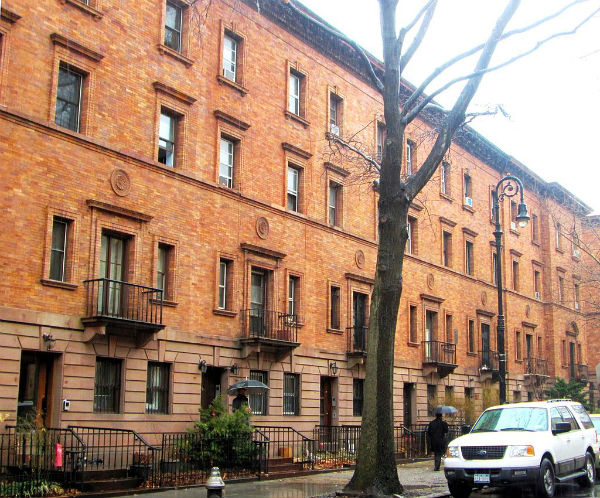Strivers’ Row is three rows of townhouses in western Harlem, in the New York City borough of Manhattan on West 138th and West 139th between Adam Clayton Powell Jr. Boulevard and Frederick Douglass Boulevard. Each of the Strivers’ Row houses is a designated landmark, and they are collectively recognized as a gem of New York City architecture.
Originally called the “King Model Houses” after developer David King, they were designed for upper-middle-class whites and constructed between 1891 and 1893. The buildings afford a view of the City College of New York, atop the hill to the west. Different architects worked on each of the three rows. The northern part of the 139th Street group was completed by McKim, Mead and White in neo-Italian style. Designers who contributed to the complex on 138th Street include James Brown Lord, Bruce Price, and Clarence S. Luce.
The houses sit back-to-back, which allowed King to specify that they would share rear courtyards. The alleyways between them are gated off (some entrance gates still have signs that read “Walk Your Horses”). At one time, these alleys allowed discreet stabling of horses and delivery of supplies without disrupting the goings-on in the main houses. Today, the back areas are used almost exclusively for parking. Strivers’ Row houses are among the few private homes in Manhattan with space for parking, but also among the few townhouses that do not have gardens in the rear.
David King’s speculative development failed, and most of the houses were soon owned by the Equitable Life Assurance Society, which had financed the project. By this time, Harlem was being abandoned by white New Yorkers. Yet the company would not sell the King houses to blacks, and so they sat empty. When they were finally made available to black residents, for US$8,000 each, they attracted hard-working professionals, or “strivers,” who gave the houses their current name.
“Between Seventh and Eighth Avenues, is 139th Street, known among Harlemites as ‘strivers’ row.’ It is the most aristocratic street in Harlem. Stanford White designed the houses for a wealthy white clientele. Moneyed African-Americans now own and inhabit them. When one lives on ‘strivers’ row’ one has supposedly arrived. Harry Rills resides there, as do a number of the leading Babbitts and professional folk of Harlem.”
Among those who lived in Strivers’ Row were Eubie Blake, Fletcher Henderson, Vertner Tandy, W. C. Handy, Dr. Louis T. Wright, Henry Pace, heavyweight boxer Harry Wills, comedian Stepin Fetchit, actor/singer Bill “Bojangles” Robinson, and preacher/congressman Adam Clayton Powell Jr.
By the 1940s, many of the houses had decayed and were converted to single room occupancies (SROs). Much of the original decorative detail inside the houses was lost at this time, though the exteriors generally remained unaltered. With the post-1995 real estate boom in Harlem, many of these buildings are being restored to something resembling their original condition.
Become a Harlem Insider!
By submitting this form, you are consenting to receive marketing emails from: Harlem World Magazine, 2521 1/2 west 42nd street, Los Angeles, CA, 90008, https://www.harlemworldmagazine.com. You can revoke your consent to receive emails at any time by using the SafeUnsubscribe® link, found at the bottom of every email. Emails are serviced by Constant Contact









